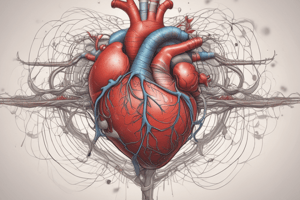Podcast
Questions and Answers
What is the primary function of the cardiovascular system?
What is the primary function of the cardiovascular system?
- To separate the chambers of the heart
- To regulate the opening and closure of the valves
- To supply blood to the body and accept it in return
- To maintain a balance between cardiac output and venous return (correct)
What type of cells are cardiac muscle cells?
What type of cells are cardiac muscle cells?
- Non-branching, uninucleate cells
- Non-branching, multinucleate cells
- Branching striated, multinucleate cells
- Branching striated, uninucleate cells (correct)
How many chambers does the heart have?
How many chambers does the heart have?
- 4 (correct)
- 2
- 5
- 3
What separates the left-sided chambers of the heart?
What separates the left-sided chambers of the heart?
What is the weight of the heart?
What is the weight of the heart?
What connects adjacent cardiac cells?
What connects adjacent cardiac cells?
What is the primary source of energy for cardiac muscle?
What is the primary source of energy for cardiac muscle?
Which side of the heart is responsible for receiving oxygen-laden blood?
Which side of the heart is responsible for receiving oxygen-laden blood?
What is the function of pulmonary circulation?
What is the function of pulmonary circulation?
Which arteries supply blood to the heart muscle?
Which arteries supply blood to the heart muscle?
Which type of blood vessel is the site of active tissue cells gas exchange?
Which type of blood vessel is the site of active tissue cells gas exchange?
Which valve allows oxygen-rich blood to be pumped to all organs of the human body?
Which valve allows oxygen-rich blood to be pumped to all organs of the human body?
Flashcards are hidden until you start studying
Study Notes
Cardiovascular Physiology
Cardiovascular physiology is the study of the function of the heart, blood vessels, and blood. The cardiovascular system consists of the heart, which is an anatomical pump, and its intricate conduits (arteries, veins, and capillaries) that traverse the whole human body, carrying blood. The primary function of the cardiovascular system is to maintain a balance between cardiac output and venous return.
Heart Function
The heart is a muscular organ weighing between 250-350 grams located obliquely in the mediastinum. It functions as a pump supplying blood to the body and accepting it in return for transmission to the pulmonary circuit for gas exchange. The heart contains 4 chambers that essentially make up 2 sides of 2 chamber (atrium and ventricle) circuits; the left side chambers supply the systemic circulation, and the right side chambers supply the pulmonary circulation. The chambers of each side are separated by an atrioventricular valve (A-V valve). The left-sided chambers are separated by the mitral (bicuspid) valve, and right-sided chambers are divided by the tricuspid valve. Blood flows through the heart in only one direction enforced by a valvular system that regulates opening and closure of the valves.
Cardiac Muscle
Cardiac muscle cells are branching striated, uninucleate (single nucleus) cells that contain myofibrils. Adjacent cardiac cells are connected by intercalated discs containing desmosomes and gap junctions. The myocardium behaves as a functional syncytium because of electrical coupling action provided by gap junctions. Cardiac muscle has abundant mitochondria that depend on aerobic respiration primarily to generate adenosine tri-phosphate (ATP), the molecule that provides energy for cellular function.
Systemic Circulation
The systemic circuit originates in the left side of the heart and functions by receiving oxygen-laden blood into the left atrium, which then flows into the left ventricle. From the left ventricle, oxygen-rich blood is pumped to all organs of the human body through the aortic semilunar valve.
Pulmonary Circulation
The pulmonary circuit is on the right side of the heart and serves the function of gas exchange. Oxygen-poor systemic blood reaches the right atrium via 3 major venous structures: the superior vena cava, inferior vena cava, and coronary sinus. This blood is pumped down to the right ventricle via the tricuspid valve and eventually through the pulmonic valve, leading to the pulmonary trunk that takes the oxygen-deprived blood to the lungs for gas exchange. Once gas exchange occurs in the lung tissue, the oxygen-laden blood is carried to the left atrium via the pulmonary veins, hence completing the pulmonary circuit.
Coronary Circulation
Coronary circulation is the circulation to the heart organ itself. The right and left coronary arteries branch from the ascending aorta and, through their branches (anterior and posterior interventricular, marginal and circumflex arteries), supply the heart muscle (myocardial) tissue. Venous blood collected by the cardiac veins (great, middle, small, and anterior) flows into the coronary sinus. Delivery of oxygen-rich blood to the myocardial tissue occurs during the heart relaxation phase.
Vessel Anatomy
An artery is a blood vessel that carries blood away from the heart to peripheral organs. They are subdivided into larger conducting arteries, smaller distributing arteries, and the smallest arteries, known as arterioles, that supply the capillary bed (the site of active tissue cells gas exchange). Capillaries are vessels that are microscopic in size and provide a site of gas, ion, nutrient, waste, and immune cell exchange.
Studying That Suits You
Use AI to generate personalized quizzes and flashcards to suit your learning preferences.




